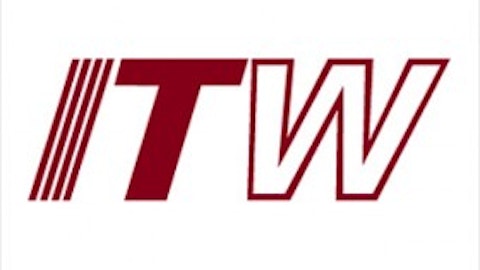Many investors might focus too much on quarterly earnings and short-term economic trends. I prefer companies with good business models which equips them with the ability to weather recessions. Praxair, Inc. (NYSE:PX), one of the largest producers and distributors of industrial gases in the world, is one of the stocks that caught my eye.
It boasts of strong recurring revenue and pricing power that is validated by its stellar financial track record. Although it is valued at a premium to its peers, this is justified by a higher relative profitability vis-à-vis its peers. I like Praxair, Inc. (NYSE:PX) for its defensiveness, given current uncertain economic conditions.
Strong recurring revenue underpinned by long-term contracts
Praxair, Inc. (NYSE:PX) typically signs 15 year take-or-pay contracts with industrial companies and constructs on-site air-separation plants supplying gases directly to their client’s facilities. In addition to the long tenure of the contracts, renewal rates tend to be high. This is because there is an element of “stickness” in this business, with alternative suppliers having to build new on-site separation plants from the scratch.
This on-site business segment accounts for about a quarter of Praxair, Inc. (NYSE:PX)’s revenue. Its merchant liquid business, representing about 30% of its revenue, is governed by exclusive supply agreements with customers located in the vicinity of its plants.
Praxair, Inc. (NYSE:PX) grew revenue by an impressive 10-year CAGR of 8.2%, with revenue increasing in every single year for the past decade except for 2009. During the Global Financial Crisis, Praxair’s revenue fell 17% in 2009, before rebounding strongly by 13% the following year.
Products have high benefit-cost ratios
Praxair, Inc. (NYSE:PX)has not suffered any loss in the past 10 years from 2003 to 2012. It has also demonstrated high gross margin stability, with gross margin staying within a narrow range of between 39%-43%. This is reflective of the pricing power enjoyed by Praxair as a result of the high benefit-cost ratio of its products.
Industrial gases are vital in the operation of customers’ facilities such as steel mills and oil refineries, but make up a very small proportion of the total manufacturing cost of its products. Consequently, customers are less price-sensitive and Praxair, Inc. (NYSE:PX) is able to maintain its gross margin in both good and bad times.
Growth drivers
Increasing intensity of gases will be the key organic growth driver for Praxair. For example, U.S. steel producers are increasingly substituting natural gas for pulverized coal or coke as a source of carbon in their production process because natural gas is cheaper. Management estimates that there is a 25% increase in oxygen usage if natural gas is used instead of pulverized coal.
In terms of inorganic growth, Praxair, Inc. (NYSE:PX) acquired NuCO2, U.S.’ largest provider of fountain beverage carbonation, in March this year. This acquisition provides two major benefits. Firstly, Praxair was previously a supplier to NuCO2; this vertical integration effort should result in positive cost synergies. Secondly, there are opportunities for Praxair to introduce this fountain beverage carbonation model in other countries where beverage carbonation cylinders are still the norm.
Peer comparison
Praxair’s peers include Air Products & Chemicals, Inc. (NYSE:APD) and Airgas, Inc. (NYSE:ARG). Praxair is valued at a premium to its peers with a forward P/E of 17.4, but it also has the highest ROA of the three at 8.3%.
Air Products is Praxair, Inc. (NYSE:PX)’s closest comparable, being the second largest U.S. industrial gases producer behind Praxair. I prefer Praxair over Air Products because Air Products & Chemicals, Inc. (NYSE:APD) has a relatively higher exposure to the under-performing electronics sector and the European region, which were responsible for a 4%-5% downward revision of full year 2013 EPS guidance at its fiscal second-quarter 2013 results call.
Praxair generates less than 10% of its sales from customers in the electronics sector, compared with Air Products which generated approximately a quarter of revenue from this segment. Semiconductor production remained weak, affecting silicon growth, with recovery in the semiconductor industry expected only in 2014, according to Solid State Technology. Air Products & Chemicals, Inc. (NYSE:APD) derived 27% of its fiscal 2012 revenue from Europe; while Europe represented about 13% of Praxair, Inc. (NYSE:PX)’s turnover for 2012. The Organization for Economic Co-operation and Development revised its growth forecast for the Eurozone downwards from a 0.1% contraction to a 0.6% slump in its latest report.
Airgas, Inc. (NYSE:ARG) is the leader in packaged gases and welding hardgoods market in the U.S. with a quarter of the market share. Praxair is a close second with about half the market share of Airgas. Airgas’ key competitive edge over competitors is its full service offering, complementing its core gas offerings with welding and on-site safety services. Airgas expects a 15%-23% growth in fiscal year 2014 diluted EPS on the back of incremental operating income gains from its SAP implementation and improved business conditions in the second half of fiscal 2014. However, I am negative on Airgas, given that it has the weakest balance sheet of the three with a gearing of 175%.
Conclusion
While Praxair seems overvalued with a PEG of 1.6, comparing its trailing P/E of 21.3 with its ROE of 25.9% shows a different picture. The relative comparison of P/E and ROE is a quick rule of thumb to determine if a stock is undervalued relatively to its profitability. In addition, its strong recurring revenue and pricing power are validated by its long-term profitability track record, making it a buy in my books.
Mark Lin has no position in any stocks mentioned. The Motley Fool has no position in any of the stocks mentioned.
The article Recurring Revenue and Pricing Power Make This Stock a Buy originally appeared on Fool.com.
Copyright © 1995 – 2013 The Motley Fool, LLC. All rights reserved. The Motley Fool has a disclosure policy.






